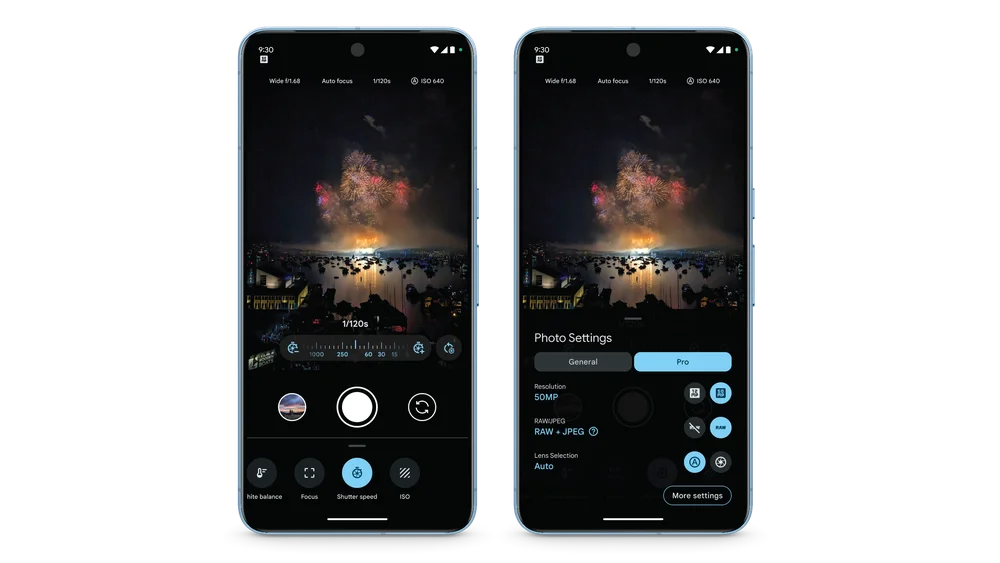
In announcing the Pixel 8 Pro, Google has confirmed that its flagship phone will bring an overhaul of the Google Camera app, bringing DSLR-like “Pro” controls for settings like focus, shutter speed, and ISO, along with upcoming “Video Boost” and Night Sight Video capabilities.
One of the core advantages of the Pixel series over the years has been the supreme quality of its still photography, primarily benefiting from Google’s machine learning expertise. The standard photo mode does everything it can to automatically turn an okay shot into a great one, while modes like Night Sight, Action Pan, and Portrait mimic the techniques of a skilled photographer with the touch of a button.
But what if you already have some practice with photography? Maybe you’ve picked up a DSLR camera and familiarized yourself with some of the many tweaks and settings at your disposal. If you wanted to apply these skills to taking photos on your phone, you simply couldn’t do it – at least not on Pixel phones, though some Android models from Sony and LG had fine-tuning controls.
That’s changing with the Pixel 8 Pro, which introduces a suite of “Pro” controls. Google started down this pathway with the Pixel 4 series, which introduced dual-exposure controls and Live HDR+ to tweak the shadows, brightness, and color temperature of your shot in real time.
Those remain and are now joined by manual controls for your camera’s focus, shutter speed, and ISO. Focus is particularly well-handled by Google Camera, introducing a picture-in-picture pop-up of a portion of the viewfinder. You can drag your finger to move the on-screen reticle, allowing you to see a close-up of any spot. Once you’re looking in the right area, a slider below the viewfinder lets you manually roll in or out of focus.

Meanwhile, ISO and shutter speed are settings you’ll likely want to adjust in tandem, depending on things like how fast your photo’s subject is moving, how firmly planted your camera is, and more. These values are typically handled automatically by Google Camera and its special modes like Night Sight, but experienced photographers may know their needs better than Google’s algorithms.
As you’d expect, each of these Pro controls can be independently adjusted or reset to automatic, stacking each control until you have the exact shot you’re looking for.
You can also take full-resolution shots on the Pixel 8 Pro, thanks to a new “Resolution” toggle in the Google Camera app’s settings. Normally, photos from Pixel phones are binned down, effectively combining the information of four pixels down to just one, often creating cleaner-looking images. Using the new toggle, you’ll be able to take full-detail 50-megapixel photos, albeit at the expense of additional time to take the photo and additional storage required to back them up.
With the significantly advanced AI capabilities of the Tensor G3 chip, Google is also including imaging capabilities directly on the Pixel 8 Pro. Magic Eraser is now able to run directly on the device, while an impressive new “Zoom Enhance” feature – reminiscent of moments in science fiction when a character says “enhance” on a blurry photo – will arrive in the coming months.
On the video front, Google is also introducing some exclusive new modes for the Pixel 8 Pro, though most will not be available immediately at launch. “Video Boost” will help create HDR videos with even better color grading than before, and you’ll soon be able to take Night Sight videos.
When recording using Video Boost, two files are saved onto your device. The first is a standard video that can be instantly shared, and the other is what Google calls a “RAW-ish” format. The latter is uploaded to Google’s servers, where it will be processed for a few hours. You’ll get a notification once the processing is complete.
In a brief demo that our team saw recently, the results from Video Boost were nothing short of impressive. Low-light video capture was greatly improved, much like existing Night Sight already does for photos, but even daytime videos were considerably better. A key detail that was particularly impressive was the typical “light bloom” that’s common in smartphone videos that contain strong light sources. In the processed video from Pixel 8 Pro, Video Boost was able to fix this completely, whereas even an iPhone capturing the same shot could not.
Combined with the significant leap in overall camera hardware – the Pixel 8 Pro includes 48-megapixel sensors for both the telephoto and ultrawide lenses and autofocus for the front-facing camera – Google is very clearly positioning the Pixel 8 Pro as one of the absolute best phones for photos and videos. You can pre-order the phone today, starting at $999.
Abner Li and Ben Schoon contributed to this article.
FTC: We use income earning auto affiliate links. More.


Comments